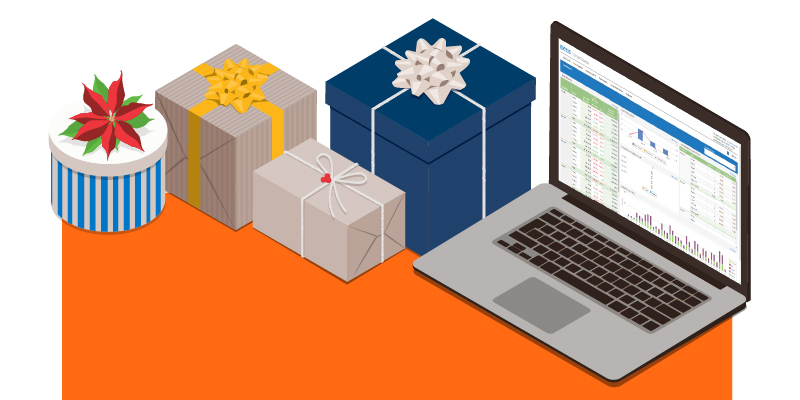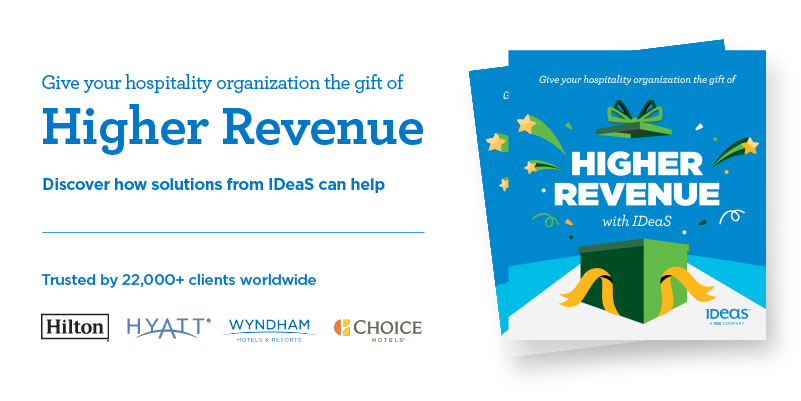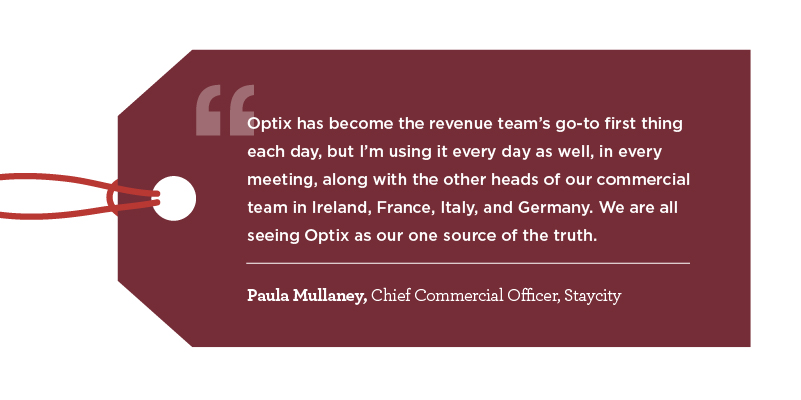Regardless of the pandemonium, the holidays offer the perfect opportunity to reflect and prepare for future success.
In other words, there’s no better time for hotels and other hospitality organizations to brush up on best practices that create successful revenue management strategies.
So, what are some of those hospitality revenue management best practices?
In the paragraphs below, we put together nine top hospitality revenue management tips for increasing profit.
Read on to discover more and set your organization up for success in the new year.
Tip # 1: Prioritize & increase guest satisfaction
If you’re thinking, “Well, this is obvious,” you’re right. However, hospitality organizations often overlook opportunities to increase guest satisfaction.
Beyond keeping rooms and common areas clean, here are some other ways to create a more satisfying experience for guests.
- Offer complimentary services: Even something as basic as a free spa visit or a complimentary ride to local attractions or the airport can build brand loyalty and make guests feel like you went above and beyond in taking care of them.
- Give rewards to returning guests: Beyond rewarding your guests with a discounted stay, consider gifting them rewards they can redeem instantly. That might mean an automatic upgrade to a nicer room, a complimentary cocktail at the bar, free parking for their rental car, or late check-out.
- Remove friction & communicate effectively: Although some would argue smartphones have made us less effective communicators, they give guests another way to communicate with hospitality organizations in a convenient and low-friction way, whether they’re requesting extra pillows or details on the local food scene.
- Bolster accessibility and inclusivity: Beyond making their facilities accessible for individuals with physical disabilities, hospitality organizations are rethinking accessibility in the digital sphere by creating apps that make booking, checking in, and checking out much easier for everyone.
- Personalize each guest experience: Leveraging your customer relationship management system can help you understand your guests’ travel experiences and tailor your offerings to match the context of their current trip. Using this insight, you can optimize your upselling offers or send more targeted promotions.
A satisfying experience with your hospitality organization makes guests feel they’re receiving their money’s worth. And when that’s the case, the likelihood of guests spending more increases, which maximizes profits for your organization.
Tip # 2: Focus on meaningful metrics
The right metrics can tell you a lot. But how do you know which ones to rely on?
Here are a few of the most important metrics for creating a successful hospitality revenue management strategy.
- Occupancy rate: This metric measures the percentage of occupied rooms in a hotel at a given time.
- NRevPAR (net revenue per available room): Calculated by dividing the total room revenue minus distribution costs by the hotel’s total number of available rooms during the measured period.
- ADR (Average daily rate): Designates the average revenue a property earns for an occupied room on a particular day.
- RevPASH (Revenue per available seat hour): If your property includes a restaurant, think of this as RevPAR for the restaurant. Measuring this KPI helps revenue managers keep labor costs low and have enough staff during busy times without overstaffing during times of low demand.
- TrevPAR: Think of this metric as RevPAR + ancillary spending. In other words, TRevPAR accounts for revenue earned across all departments, including revenue from spas, parking spaces, restaurants, meeting and event spaces, and more.
- GOPPAR (Gross operating profit per available room): Measures the correlation between a hospitality organization’s expenses and revenue. This metric offers a more accurate look at the financial health of the organization.
Regardless of the KPIs you choose, make sure you’re able to assess market conditions in real-time so that your organization can adapt accordingly.
For a complete list of the essential metrics for running a successful hospitality revenue management strategy, check out “The Next-Gen Revenue Management KPIs Hoteliers Should Be Tracking.”
Tip # 3: Apply several different strategies for pricing
It’s a mistake to assume that a pricing strategy that works for one property or location will automatically work for another.
Revenue managers should analyze the factors that most influence price for their location to avoid this mistake and find a winning pricing strategy for their property.
They can start by considering the following questions:
- Who are the experts you can lean on for advice and insight? Whose existing knowledge and experience can you leverage?
- Which pricing strategy complements your business mix the most?
- How does your pricing strategy combine with your existing channels?
- How will each pricing strategy influence distribution partners and connected channels?
- Do your guests prefer a cost breakdown that outlines the cost of their stay per day (daily pricing) or the overall cost for their whole stay (length-of-stay pricing)?
Keep in mind that your ability to forecast demand will also influence your pricing strategy, which we will get into later. Here are some of the most common (and practical) pricing strategies used in the hotel and hospitality industry.
Dynamic pricing
Also referred to as “time-based pricing,” dynamic pricing entails adjusting room rates based on real-time (or near real-time) data gleaned from the market daily.
Dynamic pricing accounts for supply and demand changes and other factors influencing demand. These factors include room availability, competitors’ prices, seasonal demand, local events, and more. By considering each factor, hotel revenue managers can set optimal prices that maximize profits and room occupancy on any given day.
Both big and small hospitality organizations employ this strategy, and many do so with the support of a revenue management system (RMS). These software solutions help hospitality revenue managers identify market trends so that they can adjust the supply of rooms and their rates to maximize profits fully.
Of course, a revenue manager doesn’t need a revenue management system. But by having an RMS analyze each market factor that would take the revenue manager hours to review each day, the RMS saves hospitality organizations serious time.
In fact, according to Hotel Tech Report’s study, What is a Revenue-Management System?, revenue managers who use an automated RMS usually save around 20 to 40 hours of work per month.
Simply put, an RMS helps your hospitality organization capitalize on shifting market conditions so that you can raise or lower your rates intentionally and maximize profits more than you’d be able to with static prices.
To discover additional benefits of an RMS and view the options available through IDeaS, download our holiday gift guide for hospitality organizations.
Tip # 4: Lean into guest segmentation
Market segmentation represents an essential aspect of revenue management that today’s hospitality organizations cannot ignore. Market segmentation helps properties develop personalized strategies to cater (and advertise) to each of them.
Segmentation starts by categorizing travelers based on their reasons for traveling. Some might visit your property while on vacation, others might be there for a wedding, while others might be there for a business trip (or vacation/wedding/business trip—it’s possible).
“Bleisure” (which is a combination of business and leisure travel) accelerated as a trend following the events of 2020. And it looks like it’s here to stay.
Regardless, many organizations are taking segmentation a level deeper today by embracing a strategy called “blended segmentation.” This strategy defines market segments based on their booking methods and their reasons for traveling.
Hospitality organizations often segment guests by the following additional factors:
- No-show ratio
- The length of time between when a guest books a room and their stay (lead time)
- Length of stay
- Cancellations
- The days of the week a guest stays
- Channel booked through
- Source market
- Rate plan
Tip #5: Dial in your promotional strategy
Once you have your guests segmented, you can dial in your promotional strategy with greater precision.
You can now decide which groups to focus on more and which to focus on less. You also know when to target prospective customers with promotions.
Suppose you realize a particular segment cancels its reservations at a higher frequency than other segments. In that case, you might redirect your marketing dollars away from that segment.
Now that you know your segments, here are some of the ways you can dial in your promotional strategy for each segment:
- Direct bookings: Create offers that guests can only book on your website.
- Group/corporate business: Offer the chance to negotiate.
- Member of loyalty and rewards programs: Tier your loyalty members by revenue potential; the higher the value of the guest, the more perks they get through discounts or value adds.
- Walk-ins: Tempt walk-in guests to spend more with the amenities that you display on location for purchases while they’re booking their stay.
- Mobile booking: Offer promotions exclusively on mobile devices and apps when demand is low or trending downward.
Again, once you have your audience segmented, your promotional strategy can become more targeted and effective and, ultimately, less of a guessing game.
So, take the time to segment your audience. And once you have that information, run and refine your promotions based on what you learn as you go along.
Maybe you run a promotion that flops with a segment. That’s okay. Write down what happened, adjust your approach, and try again. Eventually, you’ll find the winning combination.
However, using a revenue intelligence tools (like Optix, which is designed by IDeaS and built on AWS) can make the segmentation process even easier.
To discover additional benefits to using Optix, download our holiday gift guide for hospitality organizations.
Tip # 6: Forecast demand with accuracy
Beyond helping your organization establish rates that maximize revenue, forecasting the future helps when it comes time for budgeting.
An accurate forecast of future demand founded on historical data and recent trends will inform your budget and give your organization ample time to adjust to your business strategy (if needed).
So, what information should the optimal forecast include and consider?
- Bank, public, and school holidays
- Group business and events from previous years.
- Future group business and events
- RevPAR from throughout the previous year
- Indicators from benchmark providers like STR and Amadeus pointing to increased/decreased demand
- The demand level indicator from the previous year
And although it should also consider other influences, including online marketing campaigns, distribution channels, refurbishment needs, and competitor moves, the ideal budget should always focus on answering the questions: How many rooms can you sell, and at what rate will you sell them at for each day in the future?
Although you can answer these questions and put together a comprehensive forecast (and budget) by hand, the process—however important—consumes a serious amount of time. But that’s where a revenue management system can help.
To discover how revenue management technology can help you automate the forecasting process and save you significant time, check out our holiday gift guide for hotels and hospitality organizations.
Tip # 7: Evaluate the competition thoroughly
Competition fuels innovation. But for that to happen, you must keep a close eye on your competition’s moves.
For hospitality organizations, this means monitoring the following aspects of a competitor’s business:
- The level and quality of service
- Prices
- Distribution channels used by the competition
- Location
- Product categories (luxury, mid-range, budget-friendly)
Technically a business is only a competitor if they target the same prospects as you. And it’s worth noting that you and your competition might not simultaneously target the same guest segments.
However, if your organization can predict the moves and strategies of your competition, then you can adjust your strategies with greater ease and effectiveness.
Tip # 8: Work with a comprehensive revenue management system
As we mentioned earlier, you certainly can carry out an effective revenue management strategy without the support of advanced systems.
However, utilizing advanced technology—such as a revenue management system—can take your revenue management strategy to the next level (and beyond).
So, what are some of the benefits of using an RMS? How can this technology supercharge your revenue strategy?
Earn higher revenue from each room
An RMS provides data to help you know which guest segments you should target at any given point. Beyond that, an RMS will help you identify the correct rates to charge each segment, given the current demand and various other factors, including historical demand, local events, and competitor rates.
Take back your day
Yes, you can gather market intelligence by hand. Or you could let an RMS do that for you. When you understand the current and future state of demand, you can set rates that maximize income on any given day and predict staffing needs in a way that saves money while providing optimal service.
Understand (and stay ahead of) your competition
Your organization must monitor the competition to maintain an effective, profitable pricing strategy. An RMS can provide a comprehensive overview that details your competitors’ rates, allowing you to craft a more proactive response.
Decrease the cost of mistakes
Although large hospitality organizations can conceal or overcome occasional pricing mistakes, smaller operations have less room for errors. But by helping you earn incrementally more revenue from each room and revenue stream, an RMS can help reduce the costliness of a mistake when it inevitably occurs. However, your chances of making a mistake are typically lower when you use an RMS. It’s a win-win.
Boost your competitive edge against larger brands
Revenue management systems help smaller hospitality organizations compete with larger operations by providing crucial market insights and optimized pricing.
Think of an RMS as an additional employee on your team. By having it analyze data and optimize prices, you’ll gain more time and resources to compete with larger organizations that can hire full-time revenue management staff.
Store data in one central location
Think of all the time it takes to locate data stored in multiple locations. There’s a real opportunity cost to that. However, an RMS automatically compiles essential information in one place to help you save time, find what you’re looking for, and get back to what you do best.
Make moves proactively
Rather than reacting to moves your competition makes, an RMS puts you in the driver’s seat by giving you a deeper understanding of current and future demand and trends, allowing you to make informed projections and set optimal rates.
Tip #9: Increase direct bookings
Driving direct bookings represents another cornerstone of an effective revenue management strategy. Simply put, when you get guests to book their stay directly through you (as opposed to another vendor), you reduce third-party distribution costs and increase profits.
Plus, direct bookings allow you to track data that can help you modify prices and segment your guests. This increased access to data allows you to pick up on trends and identify guest behavior.
During a time when guests can easily compare prices on third-party websites, hospitality organizations can capture direct bookings by offering value incentives.
Loyalty programs, for instance, offer guests the opportunity to lock in a lower price in exchange for future business. Other tactics include offering discounts or free parking.
Bonus tip: Partner with an industry expert
If you could put together a holiday wish list for your hospitality organization, what would it include?
Would you wish for higher revenue? Or would you ask for more time in your day or help with creating forecasts or optimizing prices across all channels?
Perhaps you’re interested in boosting the efficiency of your staff and doing more with less.
With over 30 years of delivering revenue management solutions to brands like Hilton, Marriot, Radisson, and Accor, IDeaS has a way of making those holiday wishes come true.
Discover how our suite of solutions can help your business achieve its goals by downloading our holiday gift guide for hospitality organizations.





